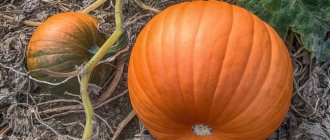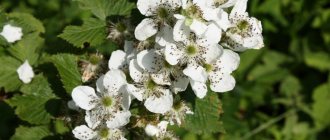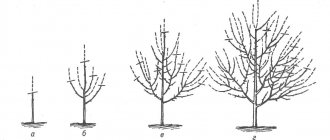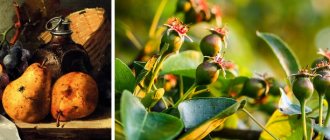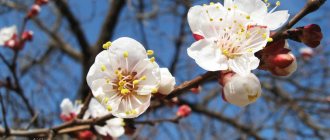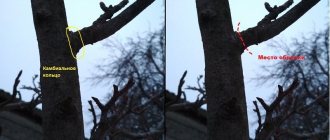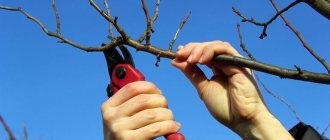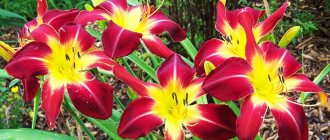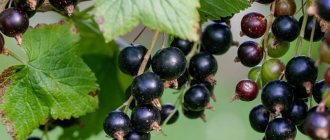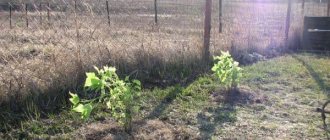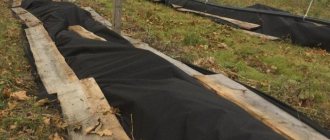Why do you need feeding?
Autumn feeding of pears is necessary for the tree to replenish useful microelements that were spent during the growing season. The pear also needs to regain its strength in order to withstand the winter cold, which it cannot easily tolerate.
The plant cannot cope without the help of a gardener. She needs to be provided with additional nutrition, which will help boost her immunity and guarantee a successful winter. Correctly fertilizing pears will guarantee a rich harvest of juicy and sweet fruits next season.
Fertilizing old and young pears
If fertilizer was applied when planting a young plant, there is no need to feed the pear for the next three years: the increased content of minerals can have a bad effect on the development of the crop.
An adult tree requires annual feeding. Depending on the condition of the pear (crown development, leaf color, fruiting and yield), their quantity must be varied.
Plants should not be overfed.
By practicing competent and timely feeding when growing pears, it will become clear what is the best way to feed a pear in the spring and what fertilizers are needed when planting a pear in order to have a good harvest of smooth and fragrant fruits.
The influence of autumn fertilizing on yield
Experienced gardeners know that the productivity of fruit trees depends entirely on the creation of optimal growth conditions, soil condition, and the presence of the required amount of micronutrients.
Fertilizing pears in the fall is carried out in several stages. After the fruits are completely harvested, fertilizing is carried out along the trunk circle. This procedure is performed when almost all the foliage has turned yellow. If the plant is young, fertilizers are applied before digging.
You should not start feeding the plant before 2 years of age. When planting, a sufficient amount of fertilizer is usually placed in the planting hole; this complex is enough for a couple of years. The soil for a pear should be fertile, but it begins to deplete and needs a new dose of fertilizer.
You may be interested in: Fertilizing flowers with castor oil
Types of fertilizers
Fertilizers are applied to pears in the fall to prepare the plant for the winter, as well as to compensate for nutrient deficiencies .
The amount and composition of fertilizers is determined by the type of soil.
Organic
These are mixtures that contain:
- Slurry. It is made from mullein or horse droppings. Fresh herbs are added to them and infused. This fertilizer contains a high concentration of nitrogen, so it is added in small doses so as not to damage the root system. In autumn, they are used to improve the structure of soil with a high humus content, making it softer and looser.
- Humus. It is prepared from healthy fallen leaves, tops, weeds and green manure, which are moistened with water and left to rot for a period of 6 to 12 months. This nutritious and safe composition is applied under digging.
- Wood ash. Contains useful elements and protects against pests.
- Bone meal. Rich in calcium and nitrogen, used for digging, no more than once every 4 years. Reduces soil acidity.
Organic fertilizer is applied to the tree trunk circle , which is dug around the perimeter of the crown. Then the soil is mulched with straw, humus and peat, taken in equal parts.
Mineral
The pear tree needs mineral fertilizers containing potassium and phosphorus most in the fall . They help the tree prepare for the dormant period.
Fertilizers are applied carefully, carefully observing the dosage :
- water - 10 l;
- copper - 5 g;
- zinc - 10 g;
- magnesium - 200 g;
- boric acid - 20 g.
The mixture is diluted in a bucket. The resulting composition is watered at the rate of 10 liters per 1 m² .
Mineral fertilizers are also used for thoroughly spraying leaves, branches and shoots of a tree . To do this, prepare a mixture based on the following components:
- water - 10 l;
- superphosphate - 2 tbsp. l.;
- potassium chloride - 1 tbsp. l.
The pear is treated with the resulting solution immediately after fruiting .
Features of fertilization
In order for autumn fertilizing to bring only benefits to the pear, and in the spring for it to easily recover from hibernation, you need to know some of the subtleties of fertilizing these fruit trees. It should be remembered that an excess of beneficial microelements can be more dangerous than their deficiency. You need to find a middle ground, and this is difficult for a novice gardener to do. If you apply too much fertilizer, the tree will wake up from hibernation too early and may die. With a small amount of fertilizer in the spring, the pear will lack nutrients and it will be extremely difficult for it to recover.
Advice from professionals
In order not to harm the plants, you need to feed the pear in the fall in a timely manner and in sufficient quantity. Professional advice and recommendations will help you avoid serious mistakes when growing fruit trees.
Recommendations:
- Before winter rest, the tree is well watered. One plant uses 20 liters of water.
- All fertilizers are applied strictly according to the instructions so as not to burn the rhizome.
- Stores sell antiseptics for treating fruit trees against fungus. After spraying, the trunks are whitened.
- When adding fertilizers, 50 cm are removed from the trunk under the roots.
- Last year's mulch is removed in the spring, and new mulch is laid out in the fall after fertilizing.
- Potassium and nitrogen are added separately; they are incompatible. They are used at different times.
- If the weather is dry and there is no rain, then liquid fertilizers are used.
- Organic matter is added only to trees older than 5 years.
- Spraying with fertilizers is carried out carefully, you need to cover all the foliage, all the branches, the trunk.
- Before frost, fertilizing is not introduced; it will not be absorbed by the plants during the cold. Feed is introduced 25-30 days before the first frost.
- If the pear does not have enough phosphorus, the yield will decrease. If the leaves become lighter, there is not enough nitrogen. With a lack of potassium, the leaves become stained and curl.
Fertilizers and folk remedies are selected for pears taking into account the variety and area of growth. The choice of fertilizer dosage for a particular plant is made taking into account the age of the tree. Properly fertilized pears will not get sick in the fall, and next year they will bloom profusely and produce a good harvest.
Second autumn feeding
The second stage of fertilization should begin when all the foliage has fallen. It will be necessary to prune the pear tree. Pruning is necessary to remove old, diseased branches. This fertilizer allows the use of products containing potassium, zinc, copper, boric acid, phosphorus, and magnesium. The main thing is to make sure that the fertilizer does not contain nitrogen. Otherwise, the tree will begin to grow actively and will not be able to survive the winter. After fertilizing, it is necessary to water the pear trees abundantly. At least two buckets of water should be poured under each tree.
Fertilizer application schedule
A pear, like any fruit tree, needs to regularly receive the required amount of beneficial microelements and nutrients. Otherwise, you can forget about delicious fruits and a rich harvest.
- After winter, you need to start feeding the pear in early spring. This must be a nitrogen-containing fertilizer so that the plant begins to develop, grow, and increase green mass. The application of fertilizer should be plentiful.
- After the first flowers appear on the pear, a second feeding should be carried out. Preference should be given to nitrogen fertilizers.
- In the autumn, after harvesting and all the leaves have fallen, mineral fertilizers are used for pears.
You may be interested in: Treating the garden in the fall against pests and diseases using various means
Foliar feeding is carried out if the summer is dry. In this case, it is difficult for nutrients to get through to the root system of the tree. They use organic products for such fertilizing; they spray the crown with them when the sun has already set.
Applying any fertilizers to the soil is prohibited without first thoroughly watering the soil. Otherwise, beneficial microelements will not be able to reach their destination.
Timing and rules for applying fertilizing for pears in the fall
The first autumn fertilizers are applied in September, after harvesting, when the foliage has all turned yellow and begins to fall off. You can feed the pear in the fall until the beginning of November; food is added for two months. Trees should not be fertilized during the cold period; the root system does not absorb nutrients at low temperatures.
If additives are added later and at above-zero temperatures, the buds may swell again, and this is dangerous for future fruiting. Frosts may suddenly begin and the buds will freeze, and next year there will be no flowering.
The timing of autumn fertilizing is from September 10 to early November. The first fertilizing is done after fruiting, the tree is fertilized a second time 3 weeks after the first fertilization. The third time the pear is fed is in the winter - 3 weeks before the first frost, so that the plant can more easily endure the winter.
Scheme and methods of feeding pears in the fall:
- Fruit trees are fertilized in 3 ways: in furrows, by digging up the ground, using foliar nutrition. When digging the soil, dry nutrient mixtures are added, they are distributed in a circle around the trunk, then the soil is dug up. The trunk diameter around the tree should be equal to the width of the crown. This is easily visible in sunny weather, when a shadow falls on the ground from the foliage.
- Liquid mixtures are added to the grooves that are made around the tree. Furrows are dug 30 cm deep near old plants and 15-20 cm near young plants aged 3-7 years. Pour the solutions into the grooves and cover them with earth.
- Foliar feeding is done by spraying the tree crown with complex preparations. The procedure is done once in the fall. The product is diluted more strongly than with root fertilizer; the younger the pear, the lower the concentration of the drug.
Important!
An overdose of fertilizers can harm the fruit tree.
How to feed a pear in the fall
There are many fertilizers that can be used to feed pear trees. Which of these fertilizers are needed and how do they affect trees? How much fertilizer can I use?
Organic fertilizers
Organic fertilizers are useful for pears, but only in the spring. In the spring, when the plant has just woken up, organic matter will be most useful. In autumn it is better to give preference to mineral complex fertilizers.
Mineral fertilizers
Using mineral fertilizers in the fall is a smart approach and the choice of experienced gardeners. It is easy to purchase such fertilizers; they are available in any garden supply store. We can recommend using the following fertilizer: Dissolve 1 tablespoon of potassium chloride and 2 tablespoons of superphosphate in a ten-liter bucket of water. The solution is mixed, poured over the pear not under the trunk, but in a circle near the trunk.
Types of fertilizers
Mineral fertilizers are inorganic compounds containing microelements in the form of salts necessary for cultivated plants. Organic fertilizers are fertilizers that contain nutrients in the form of organic compounds.
There are three methods of introducing fertilizers:
- for digging;
- into nutrient wells or ditches;
- foliar spraying.
Dry mixtures are usually added under digging. They are scattered around the tree, approximately over the area occupied by the roots, and the top layer of soil is carefully dug up.
On a note!
Fertilizer solutions are injected into wells and ditches. Dig holes up to 20 cm deep around the perimeter and pour in a nutrient solution.
Holes are made at the rate of 1 hole per 1 m2 of area. Ditches are dug around the trunk throughout the entire area. The depth should not exceed 30 cm and the solution is also poured. Foliar feeding is carried out once in the fall by spraying nutrient solutions onto the crown.
Folk remedies for feeding pears
There are many popular recipes that have been tested by gardeners over the years. Even neighbors in the country will be able to share their recipes on how to process pears in the fall. We offer just a few tips:
In the fall, you can use wood ash to feed pears. You will need at least 150 g for each square meter of dug soil. The ash is evenly distributed over the entire surface of the soil. A rake is used to embed the ash to a depth of 0.1 m. Wood ash is an excellent fertilizer suitable for young and mature plants.
After applying fertilizers and thoroughly watering the soil, be sure to mulch. Rotted humus, peat, and pine bark are suitable as mulch. The main thing is that the mulch retains moisture at the roots of the tree for a long time, allowing it to feed on beneficial microelements from the soil for a long time.
You may be interested in: Eggshells as fertilizer, how to use
It is recommended to whitewash pear trunks with a solution of copper sulfate and lime in November or October. You can use chalk emulsion if the seedlings are very young. The base of the trunk is tied to prevent rodents from damaging the bark in winter.
Other types of fertilizers for autumn pears: methods for preparing them
In fact, in the fall, as in the spring, the same fertilizing recipes and planting methods are used. If you plan to plant a pear in the fall, then the holes are prepared in the spring and vice versa. The only difference between seasonal feedings is the proportions of substances and the number of feedings during the autumn and spring periods.
The foliar method of fertilizing in the fall is not used for pears..
Many years of experience of gardeners help beginners apply the necessary fertilizers correctly and without damage to the plant in the autumn season.
Method 1 - for young pears (root feeding): superphosphate and potassium chloride are dissolved in 10 liters of water (tbsp.) in a ratio of 2:1.
A greater effect is achieved if wood ash is added to a depth of 10 centimeters around the trunk. It contains many useful microelements and protects the horse ball from rotting. Digging is done from above.
Method 2 - to make trees come out of hibernation faster: add chemicals (in grams) to a bucket of water - boric acid (15), potassium (100), magnesium (150), phosphorus (200), zinc (10) and copper (5 ).
It is better to introduce root feeding into grooves up to 30 cm deep, dug to a distance around the circumference of the pear crown.
Method 3 – planting siderites (after harvesting): winter rye, wheat or oats are suitable crops. They hold snow and hide the root system of the fruit tree from frost. In the spring, after the snow melts, they simply dig it up.
Method 4 – for northern regions, fertilizing with potassium fertilizers: 200 grams of potassium salt, potassium sulfate or potassium chloride are used per tree.
These substances can be applied along the trunk of the pear or placed in the grooves near it.
Method 5 – adding humus (for any soil): 10 liters per 1 square meter of land.
Mullein or horse manure is used for this process only if it has had time to rot. Otherwise, the pear can be ruined.
In the autumn season, chicken manure for pears should be applied dry mixed with soil.
A pear tree bears fruit for up to 20 years.
Tips for beginner gardeners
- It is recommended to start feeding the pear two years after planting.
- Foliar feeding is carried out only after sunset or in very cloudy (not rainy) weather.
- Spraying pear trees with a urea solution (1%) gives good results. Only such fertilizing should be carried out after the completion of the mass flowering stage. It is better to do this in ten days, and after another two weeks, repeat the treatment of the pear.
- You need to be careful when using macro fertilizers. Their dosage depends on the condition of the fruit trees and the season. The standard rate is one and a half kilograms of fertilizer per 1 square meter of tree trunk circle. But it is better to read the instructions and adhere to the specified proportions.
Spending on fertilizers is insignificant; autumn work in the garden will not take much time and effort. But autumn feeding of pears will allow you to annually obtain a rich harvest of juicy, tasty fruits. feeding
Advice from experienced gardeners
Before applying fertilizers, you need to familiarize yourself with the advice of experienced gardeners:
- Organic matter can be applied to trees older than 4 years.
- Nutrients are absorbed within 3-4 weeks, so it makes no sense to fertilize before the onset of frost.
- Before feeding, prepare the pear: remove dry, broken branches and foliage around the trunk.
- Lightening of the foliage indicates a lack of nitrogen. Therefore, in mid-August, the pear can be fed with nitrogenous fertilizers. The main thing is to follow the dosage, otherwise the plant may not overwinter well, and in the spring a large amount of foliage will bloom on the tree to the detriment of the harvest.
- If the pear tree is not fed with phosphorus in the fall, it will not produce leaves and form fruit.
- If by the end of summer the foliage is curled and covered with spots, it means that the supply of potassium has dried up. It is this mineral that the pear will especially need in winter. And if the foliage turns pale and turns purple at the edges, it means that the plant lacks magnesium and needs to use complex mineral supplements.
This is interesting: Nutria breeds with photos and descriptions: the most popular on the market

